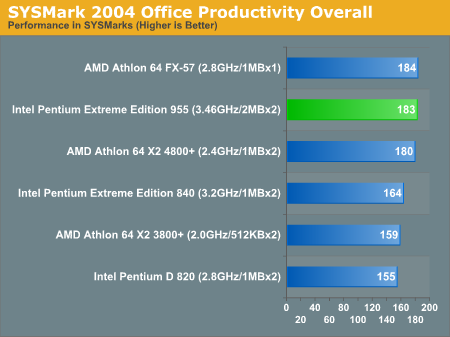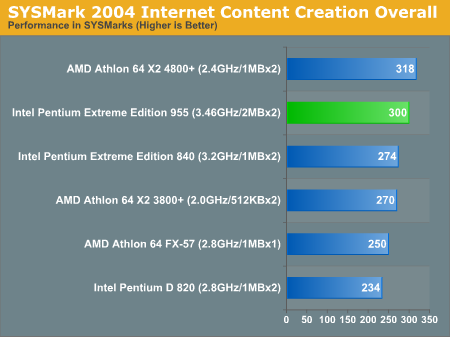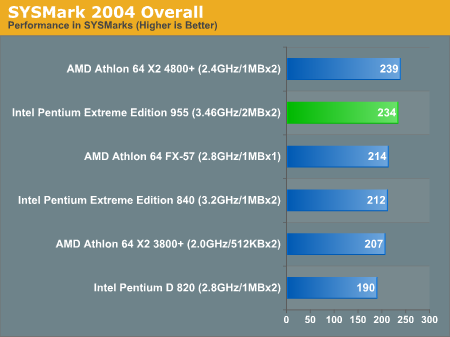Intel's Pentium Extreme Edition 955: 65nm, 4 threads and 376M transistors
by Anand Lal Shimpi on December 30, 2005 11:36 AM EST- Posted in
- CPUs
Overall Performance using SYSMark 2004
Office Productivity SYSMark 2004
SYSMark's Office Productivity suite consists of three tests, the first of which is the Communication test. The Communication test consists of the following:
ICC SYSMark 2004
The first category that we will deal with is 3D Content Creation. The tests that make up this benchmark are described below:
Office Productivity SYSMark 2004
SYSMark's Office Productivity suite consists of three tests, the first of which is the Communication test. The Communication test consists of the following:
"The user receives an email in Outlook 2002 that contains a collection of documents in a zip file. The user reviews his email and updates his calendar while VirusScan 7.0 scans the system. The corporate web site is viewed in Internet Explorer 6.0. Finally, Internet Explorer is used to look at samples of the web pages and documents created during the scenario."The next test is Document Creation performance:
"The user edits the document using Word 2002. He transcribes an audio file into a document using Dragon NaturallySpeaking 6. Once the document has all the necessary pieces in place, the user changes it into a portable format for easy and secure distribution using Acrobat 5.0.5. The user creates a marketing presentation in PowerPoint 2002 and adds elements to a slide show template."The final test in our Office Productivity suite is Data Analysis, which BAPCo describes as:
"The user opens a database using Access 2002 and runs some queries. A collection of documents are archived using WinZip 8.1. The queries' results are imported into a spreadsheet using Excel 2002 and are used to generate graphical charts."

ICC SYSMark 2004
The first category that we will deal with is 3D Content Creation. The tests that make up this benchmark are described below:
"The user renders a 3D model to a bitmap using 3ds max 5.1, while preparing web pages in Dreamweaver MX. Then the user renders a 3D animation in a vector graphics format."Next, we have 2D Content Creation performance:
"The user uses Premiere 6.5 to create a movie from several raw input movie cuts and sound cuts and starts exporting it. While waiting on this operation, the user imports the rendered image into Photoshop 7.01, modifies it and saves the results. Once the movie is assembled, the user edits it and creates special effects using After Effects 5.5."The Internet Content Creation suite is rounded up with a Web Publishing performance test:
"The user extracts content from an archive using WinZip 8.1. Meanwhile, he uses Flash MX to open the exported 3D vector graphics file. He modifies it by including other pictures and optimizes it for faster animation. The final movie with the special effects is then compressed using Windows Media Encoder 9 series in a format that can be broadcast over broadband Internet. The web site is given the final touches in Dreamweaver MX and the system is scanned by VirusScan 7.0."












84 Comments
View All Comments
yacoub - Tuesday, January 3, 2006 - link
Yet no mention of the Max, where the 4800+ utterly trounces the two Intel chips. Does Max not matter (in which case why bother listing it), or does it matter but you just neglected to mention that (whether on purpose or by accident)?
jjunk - Tuesday, January 3, 2006 - link
It's right there in the chart. As for further discussion not really necessary. Screaming frame rates might look good on the chart but they don't help game play. A 10 fps min will definately be noticiable.
IntelUser2000 - Sunday, January 1, 2006 - link
'I don't like that paragraph. It makes it sound like 65nm will be all that makes Presler in power consumption. It will also make people judge 65nm based on Presler, since that's the first CPU on the 65nm.
In fact its not that simple. Taking a CPU that's on a certain process like the Smithfield and putting on a smaller process won't mean instant 40-50% decrease in power consumption. That's called the dumb shrink. The reason Northwood had significantly lower power than Willamette was because Northwood was optimized to lower power consumption.
A CPU that runs well at 130nm may do bad at 90nm and even worse at 65nm for example. Presler was said to be not Intel's main focus and Intel moved their design teams to Conroe, so people who's supposed to be optimizing Presler for 65nm all went away and Presler was just done a dumb shrink.
Sleep transistor was an optional feature on 65nm, not required. So Presler may not have it.
IntelUser2000 - Monday, January 2, 2006 - link
Why use DDR2-667 with 5-5-5-15 timings?? Most DDR2-667 can do 4-4-4-8(around there). This is gonna skew the results in AMD's favor as DDR400 used is the lowest latency possible.In reality nobody is gonna use DDR400 at 2-2-2-7 lateny or DDR2-667 at 4-4-4-8 latency. Nobody I have ever heard in outside internet uses the RAM at those timings.
Anandtech should either benchmark them all at JEDEC timings or use them all with low latency. I understand they want to be sure the new test system to work properly, but using low latency RAM for the comparison system is just not fair.
JEDEC timings for DDR400 is 3-3-3-8. Where are your DDR400 advantage over DDR2 now??
hans007 - Sunday, January 1, 2006 - link
i think that the 9xx series is a big improvement over the 8xx.i have an 8xx myself the 820 which is the lowest power. the leakage is exponential so the 955 is going to draw a much highe ramount than say a 920 will.
i bet the 920 will be a half decent cpu drawing maybe only 70 watts. which isnt TOO terrible in the grand scheme of power. the 920 would only run at 2.8 ghz and have not as high leakage percentage so i think it will be the one to get.
true intel is not better yet, but they are getting there. and their dual cores still cost less.
i also think that intel should be commended for writing the smp code for q4. that is the doom3 engine which will go into a LOT of games. and since it speeds up the amd chips as well, it is a free upgrade for everyone. sure it makes up for a large deficiency in the intel chips, but it is FREE.
and it makes the really cheap 920/820 chips very price competitive. as the 820 chips are very very cheap about $150 on ebay (which is probably near what oems get them for in bulk, this the rampant dell 820 deals going on)
jjmcwill - Saturday, December 31, 2005 - link
I do professional software development for a living, using Visual Studio 2003 to build the code for a product I work on. We have over 1000 .cpp files and over 1500 header files.On my work box: An HP xw6200 workstation with a single 3.0GHz Xeon CPU, 2MB L2 cache, 1G RAM, compilation takes 10:45 for a single project in our solution. On my home system: Socket 754 Athlon 64 3000+, 1.5G RAM, compilation takes 7:30. Both systems build the code off of the exact same, external ide hard drive in a Firewire enclosure. I use it to carry all my work back and forth between work and home.
At some point we'll be investigating Make to launch parallel compiles, and I would be VERY interested in seeing dual-core CPU comparisons which include compilation benchmarks, using Visual Studio 2003 under Windows, using Make -j2 or Make -j3 under windows, and using gcc/make under Linux.
Based on what I've seen with the Xeon, I'm leaning toward an AMD X2 or dual core Opteron for my next upgrade.
Thanks.
Calin - Tuesday, January 3, 2006 - link
I think that an Extreme Edition CPU (while much more expensive) would give better results with hyperthreading enabled than a simple Pentium D and maybe even than an Athlon64 X2 while doing several threads of compile.Brian23 - Saturday, December 31, 2005 - link
The second valuable post in this thread.I own a X2 3800 and I'm pleased with the results anand posted. I won't need to upgrade for a while.
I'm looking forward to AMD implementing something similar to Sun's design: multiple threads running simultaneously. It shouldn't be that hard to do. It's just adding GPRs and a little logic that controls the thread contexts.
Missing Ghost - Saturday, December 31, 2005 - link
Some other web sites report that the cpu becomes too hot with the stock heatsink.Gary Key - Saturday, December 31, 2005 - link
The initial press release kits that contained the Intel D975XBX motherboard had an issue that created higher than normal idle/load temperatures. We have new boards on the way from Intel. I can promise you that the first results shown in other 955EE reviews do not occur on the 975x boards from Gigabyte and Asus, nor will it occur on the production release Intel D975XBX. I highly recommend a different air cooling system than the stock heatsink but most of the reported results at this time are incorrect.